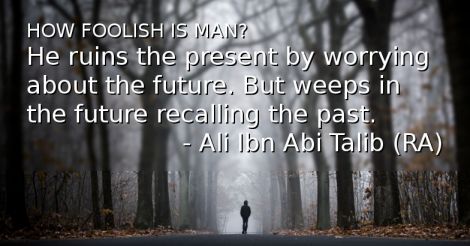There is a story about a woman who was standing by a river bank, panic-stricken and crying. A man who was passing by asked her what the problem was. She said: “There is a dog barking at me from the other side of the river. I am fearful that he will attack me.”
“But madam,” the man said, “the dog is standing on the other side of the river, and is tied to a tree. Besides, he may be barking at something else. Why are you so afraid?”
The woman said: “He is going to break free and attack me.”
The man said: “But there is still the river in between you and the dog! How could he get to you even if he broke free?”
The woman replied: “What if the river dried up?”
This is the standard example of catastrophic thinking. People who do this can turn an everyday event into a panic situation, grossly overestimating the probability of a negative outcome, defying logic each time. They will selectively identify the worst-case scenario, firmly believing that it will happen.
A familiar situation is when their child is a bit late to come home after school, some parents fear the worst and immediately enter into a panic mode. Only later would they realize that the child had extra classes, which the teacher had mentioned the other day.
Most of us do this to some extent, but in some, such pessimism can be so pervasive and overpowering, it can consume their lives – and of those around them.
Also read: Everyday Health | The basics about pain and painkillers: a user’s guide
 Mark Twain refers to people who indulge in catastrophic thinking, asserting that in life, most of our worst fears are unfounded and do not ever happen.
Mark Twain refers to people who indulge in catastrophic thinking, asserting that in life, most of our worst fears are unfounded and do not ever happen.Why do people engage in catastrophic thinking?
Such people tend to be of anxious disposition, and may have had negative experiences which prompt them to overestimate the odds of terrible outcomes happening to them. They might have heard about such outcomes in the news or had relatives or friends who suffered a catastrophe, leading them to generalize. They tend to view life events through a magnifying glass – and may suffer from ‘attentional fixation’ refusing to consider more benign and logical alternatives that are far more likely to happen.
For example, after hearing repeated media reports about stray dogs, when such a person sees a dog sitting quietly by the roadside, they might think: “It is a stray dog, it will certainly have rabies, it is going to come and bite me; and then I am going to die of rabies.”
On the contrary, the logical person might think: “Out of tens of thousands of stray dogs, only a handful of have rabies. Hence it is extremely unlikely that this dog has rabies. Some dogs can however be unpredictable when approached. Therefore, as long as I leave this dog alone, it is not going to attack me.”
Why we remember the bad experiences more than the good?
Everyone can relate to this. If we look back at the events in our life in the past month, we are more likely to remember an argument with a colleague or an accident on the way to work rather than a peaceful breakfast or the prompt completion of a task at work. On Facebook, we remember an obnoxious comment by a stranger more than the supporting words of a friend.
Bad memories are stronger as they get cemented by our emotional response at that moment. Fear is part of our basic survival instinct that helps us focus harder during the single event, momentarily blocking out other distractions, thus creating a razor-sharp memory of that moment. Besides, each time we recall this event, the memory gets stored again, reinforcing it into our ‘cache’ or working memory, thus popping into our head while sitting idle.
Negative memories are known to get stored faster than positive memories. While this might seem rather depressing, there is an upside as well - it is the negative events that teach us to stay safe and also become better people to a large extent. For example, a negative comment on our style of driving could make us a better driver- as long as we are willing to work on it. Besides, from an evolutionary standpoint, we are programmed to acquire a clear memory about potentially threatening situations we encounter earlier in life.
However, dwelling on negative events relentlessly will do more harm than good – and one such consequence is catastrophic thinking.
Also read: Everyday Health | It is possible to defeat colon cancer -- if we are proactive
 Centre of fear: Amygdala is the part of the brain that records, recalls and responds to fearful experiences
Centre of fear: Amygdala is the part of the brain that records, recalls and responds to fearful experiences The overactive amygdala, and the neurology of fear
Just as any building should have a fire alarm system that automatically turns on an overhead water sprinkler system as soon as smoke or fire is detected, we have the amygdala in our brain that warns us of danger and helps us launch the fight or flight response. ‘Flight’ refers to fleeing from a threat that may seem too dangerous to tackle, while ‘fight’ is about physically attacking the predator in order to survive. Both responses require considerable energy - at ultra-short notice.
Amygdala is an almond-shaped body located in the temporal lobe of the brain. It is a part of our emotional nervous system, also known as the limbic system. The limbic system controls our emotions, learning, memory and behaviour. It is elaborately connected with other parts of the brain and the body.
The amygdala receives signals from our five sense organs, and has been called the emotional window through which we see the world. Early experiments with ablation of amygdala produced animals that felt no fear. It is now known that amygdala has a multitude of functions, of which fear management is the most discussed.
The amygdala is essential for survival of all animals, being able to record, recognise and respond to threats. It learns from experience. When we or someone close to us suffer a scary experience, it records that event and alerts us early the next time we face such a situation. This is essentially how we learn to stay safe.
In prehistoric days, when man roamed the forests, there was substantial risk of being eaten by predators. Men who survived such attacks could recognise these warning signs, such as the stripes of a tiger, the smell and sound of an elephant, the ominous rustling of the leaves or the hiss of a snake – all of which had been recorded by their amygdala. This ‘amygdala tape’ prepared man for instant emergency response the next time such signals were encountered.
Also called the amygdala hijack, this process instantly summons all available energy. Once the amygdala takes over, it shuts down the neo-cortex (the higher thinking centres of the brain) so that man is able to act quickly and decisively, without wasting time deliberating - for instance whether the stripes he saw could be from a zebra that dipped itself in yellow colour, or whether he should gather more fruit before leaving the scene. Instead of running away as fast as he can, spending time thinking in such an emergency could result in his being eaten up. This is the importance of shutting down the neo-cortex.
In modern times, there are no more threats from predators, but our body is programmed no different. Instead of the stripes of the tiger, we may record the visuals of a cockroach or a traffic snag as alarm signals that set off our amygdala to prepare our body for the same flight or fight response.
Some people develop a persistently overactive amygdala, much like a fire alarm system that goes off even without smoke or fire, causing unwarranted stress and disrupting their routine. The prospect of missing a deadline for submitting a paper may cause such a person to catastrophize about being fired from the job and remaining unemployed and bankrupt. This is a clear case of wasted resource, not unlike arming a nuclear warhead to chase a rabbit off our vegetable patch.
Anxiety disorders have an overactive amygdala as a common thread, and this includes people with catastrophic thinking.
Also read: Everyday Health | Information overload: how it can make our brain freeze, even lower our IQ

Being weak at math doesn’t help
Difficulty with understanding fractions is a reason for misinterpreting news reports about catastrophic events. A person with catastrophic thinking may refuse to board a flight because he read about a plane crash recently. He has difficulty comprehending fractions, and sees only the numerator. The way he sees it, because he heard about it in the news, the chance of a crash is 100%. On the other hand, logical people would ask: "Among how many safe take off and landings did a crash occur?"
If the plane crash was the numerator, then the total number of flights will be the denominator. In fact, thanks to safe aviation standards, a plane crash occurs only once every 12,00,000 flights. This also means that 11,99,999 flights took off and landed safely with no one talking about it, before we heard about the one crash. Once the math is done, it becomes clear that flying is safer than using the road - we are more likely to die on the way to the airport than while travelling on a plane.
This phenomenon, called denominator blindness, was originally described in a paper from Harvard that demonstrated how some people only looked at the numerator and were therefore unable to make sense out of numbers thrown at them.
People with denominator blindness commonly encounter difficulty when their doctor explains the risks of a surgical procedure. They panic as soon as they hear that a complication can occur - even if it is a small number of cases. As they fail to consider the denominator in their calculation, they convince themselves that every time an operation is done, a complication will happen.
Logical people will figure that if the odds of the complication are 1/1000, it also means that the success rate is 99.9%, and that 999 times the operation is successful when done. They realize quickly that it is a perfectly acceptable risk, considering the alternative of leaving the disease untreated.
What are the consequences of catastrophic thinking?
Panic attacks can happen in response to such thoughts. The person abruptly starts hyperventilating, develops palpitations and cold sweaty hands – and may believe that death is imminent. Such spells last for several minutes and can happen randomly, for example while at the office.
Catastrophic thinking is a common problem among medical students, sometimes dubbed the “medical student syndrome” where students who read about serious diseases would diagnose themselves with it.
Self-diagnosis of heart disease and cancer is common among those who regularly check the internet, at the slightest symptom. Almost invariably, these turn out to be something trivial. The danger of self-diagnosis by using the Internet was elaborated in my earlier article.
People with borderline personality disorders may jump into catastrophic conclusions of infidelity and rejection upon trivial cues - for instance, if their partner forgets to kiss or wave goodbye while driving off to work one day. People with such disorders can even be driven to suicide attempts by relatively minor events such as lower grades than expected in exams, or romantic disappointment in college.
Regardless of the background, catastrophic thinking puts the body into ‘fight or flight mode’, with stress hormones such as adrenalin and cortisol being released in large amounts, heart beating faster and the lungs taking in more oxygen with heavy breathing - as the whole body prepares for an emergency that never existed. Such stress tires the body quickly, lowering the quality of life and productivity.
The other end of the spectrum
On the one hand we have people who won’t board a flight or take an antibiotic due to disproportionate and illogical fear of adverse outcome, while at the other end of the spectrum there are a people who take extraordinary risks in everyday life - whose continued survival seems nothing short of a miracle.
Examples include those who zoom around on superbikes without a helmet along crowded roads, sometimes performing stunts that defy gravity. Drug users and binge drinkers suffer from the same deficiency. In contrast to those with catastrophic thinking who habitually come up with extreme consequences, these people fail to consider even logical consequences of their everyday actions. These are situations where even a small dose of catastrophic thinking could have been a good thing.
Also read: Everyday Health | Hepatitis B: an ounce of prevention is worth a pound of cure
 Unsafe use of a two-wheeler is a common example of inability to see even the most logical catastrophic consequence. Almost all two wheeler riders will eventually experience a fall, when a helmet can mean the difference between death and survival.
Unsafe use of a two-wheeler is a common example of inability to see even the most logical catastrophic consequence. Almost all two wheeler riders will eventually experience a fall, when a helmet can mean the difference between death and survival.How to overcome the habit of catastrophic thinking
1. Writing down each of our fears and dispassionately listing all the possible outcomes is an effective way to remove the bias we harbor in our minds towards negative outcomes. Left to its own, an anxious mind might not consider all the logical outcomes, choosing to dwell instead on only the catastrophic consequences. Evidence to the contrary might get ignored.
The advantage of using a pen and paper as opposed to thinking is that our mind is unable to play tricks on us once something is written down. The writing exercise is best done initially in the presence of a dependable friend or counsellor who can help us stay on track with some sound reasoning.
2. Ask an expert. The best way to dispel irrational fear is to ask an expert. For example, we might hear on TV that the water level in a dam has dropped to ‘record low’ levels and that calamities such as drought and famine are imminent. Instead of panicking, it is useful to ask the civil engineer or a meteorologist who will give a more balanced view of the situation.
An expert will reassure that over a period of ten years, fluctuation in rainfall is common, and that one dry season doesn’t mean the end of the world. The same principle applies to stock market crashes, where television news channels might foretell doom, but the real experts will sit back and enjoy the ride, knowing it will bounce back as it always did.
3. Swap roles: A useful exercise is to imagine that we are trying to explain this to another person who is having the same catastrophic thought. We will then be forced to critically analyze the facts and present a more balanced view, opening our own mind to logical thoughts in the process.
4. A thought is after all just a thought. Thoughts are just imaginary products of our conscious mind that can grow rapidly unchecked. Our mind can trick us into believing that our catastrophic thoughts are a reality. Many people fantasize about imaginary enemies doing horrible things to them. It is useful to search for and destroy such thoughts early before they grow and branch out into elaborate pessimistic scenarios.
Also read: Everyday Health | Fatty liver: are you at risk of cirrhosis?
 Eisenhower’s advice is helpful in channeling our mind into more constructive ways and to avoid negative ruminations
Eisenhower’s advice is helpful in channeling our mind into more constructive ways and to avoid negative ruminations5. Live in the present. Many of us tend to focus on the past, particularly on negative events that hurt us, or ruminate on our mistakes (“If only...!”). Others keep worrying about the future, constantly imagining assorted negative outcomes (“What if...?”). Training our own mind to focus on the present is a great tool to ward off negative thoughts. This isn’t easy by any measure, as old habits die hard.

6. Train the amygdala well: While getting rid of the old amygdala tapes can be difficult, we could do well not to invoke our amygdala for trivial matters in the future. Also known as emotional thinking, we should reserve it only for truly serious events in our life and career.
Whenever possible, it is better to avoid letting our amygdala launch a flight or flight response for non-urgent situations like a misplaced pen, low grades on a class test or a rejected job application - each of which requires calm, non-emotional thinking and planning using our neo-cortex.
Parents must be cautious about revealing their own negative emotions as children are always watching, and readily copy their parents’ behavioral quirks.
7. Get professional help: Those who suffer from persistent catastrophic thinking may have an underlying mental illness and will need to consult a mental health professional. The amygdala and our thought processes can be retrained by scientific techniques like cognitive behavior therapy (CBT) and psychotherapy. Medications may be required in some instances. Relaxation techniques help with maintaining continued wellness. The stigma to consult a psychiatrist remains a significant barrier to progress, as elaborated in my earlier article.
In summary, catastrophic thinking refers to the relentless expectation of the worst-case-scenario even for routine life events. It can exist as part of one of the anxiety disorders or just as a personality trait. While our innate ability to predict reasonable consequences of life events enables us to act with purpose and safety, catastrophic thinking is counterproductive and disabling, sometimes even destructive. Though originally meant for our own protection against danger, if the amygdala is triggered excessively, it leads to unnecessary stress, bad decisions, disrupted relationships and poor quality of life. Some of the above-mentioned mind-training techniques can be helpful in mild situations. As catastrophic thinking is linked to the subconscious emotional nervous system, professional help will be required in severe cases.
Further reading
1. What psychologists say about catastrophic thinking.
2. How patients with borderline personality disorder catastrophize
3. Denominator blindness: why some people can’t understand fractions
5. How we develop strong but fragmented memory of negative events, while forgetting the context
6. How negative emotions enhance memory of events
7. Trends in Rainfall in Kerala: the big picture
8. How to train our mind to avoid negative thoughts and become more positive
9. The fight, flight or freeze response
10. Stress in Health and Disease: Bengt B. Arnetz, Rolf Ekman
(The author is a senior consultant gastroenterologist and deputy medical director, Sunrise group of hospitals)

























